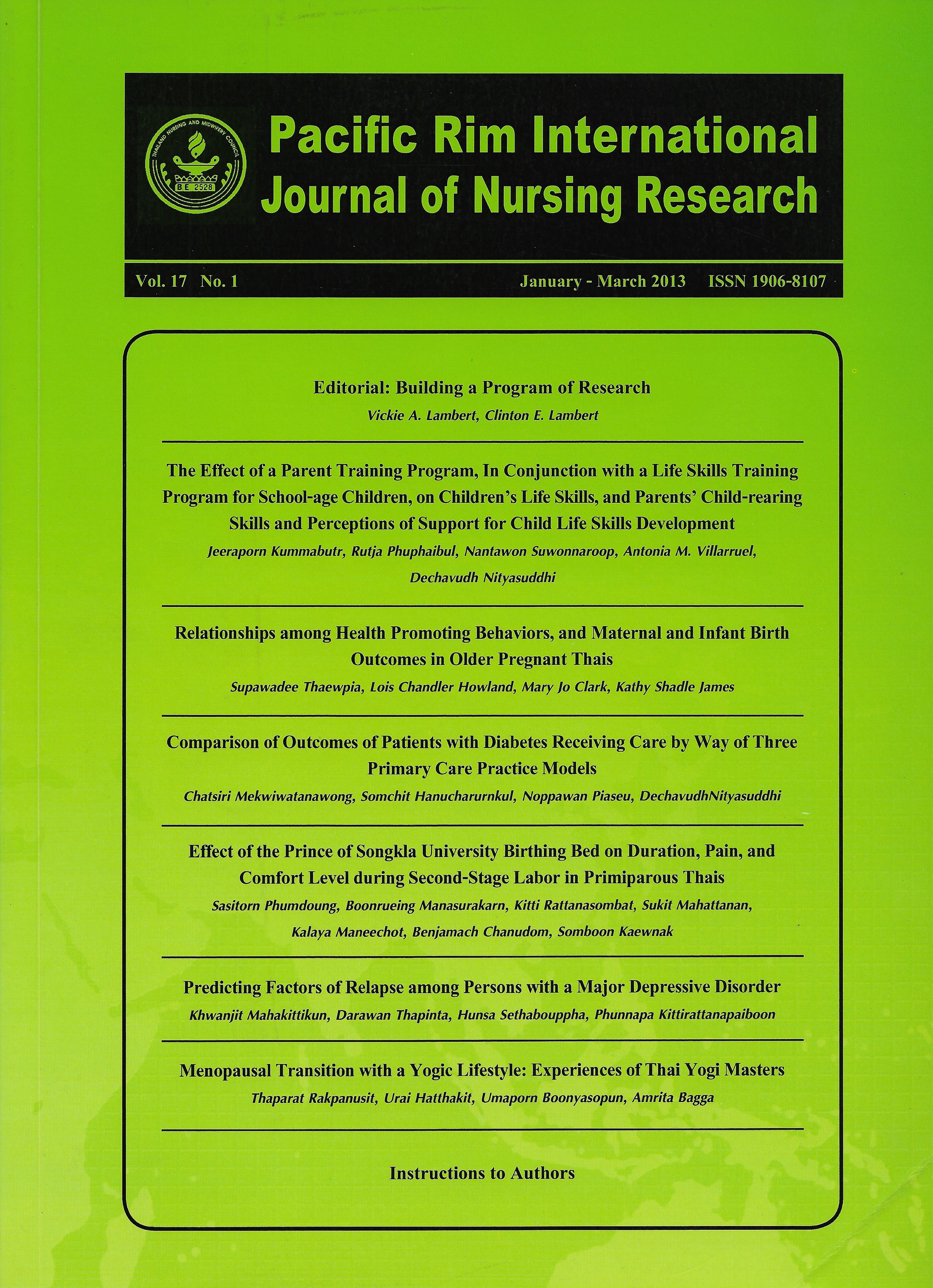Effect of the Prince of Songkla University Birthing Bed on Duration, Pain, and Comfort Level during Second-Stage Labor in Primiparous Thais
Keywords:
PSU birthing bed, Labor pain, Duration of second-stage labor, Comfort level, LowerAbstract
Abstract: The aim of this study was to test the effectiveness of the newly created Prince of Songkla University (PSU) Birthing Bed regarding duration of second-stage labor, sensation and distress of labor pain, lower back pain, and comfort level during the second-stage of labor of primiparous Thais. The sample consisted of 240 primiparous Thais, who were block randomized into four groups and, subsequently, during labor, placed in four different types of beds (60 women per group), including the: PSU Birthing Bed without a holding bar; PSU Birthing Bed with a holding bar; usual birthing bed with head elevated 45-60 degrees; and, usual birthing bed with head elevated 15 degrees. Demographic, obstetrical and infant data were obtained via a researcher-developed data sheet. Demographic data were obtained directly from the women, while the obstetrical and infant data were obtained from the women’s medical records. Information regarding each subject’s experience of sensation and distress of labor pain, lower back pain and comfort level were collected via use of 100 mm Visual Analogue Scales.
Data were analyzed using descriptive statistics, ANOVA, Kruskal-Wallis test, Mann-Whitney U test, and Chi-square. Analysis revealed those who used the PSU birthing bed without the holding bar, and the PSU birthing bed with the holding bar, had a significantly lower duration of second-stage labor, less sensation and distress of labor pain, less lower back pain, and greater comfort than those who used the usual birthing bed with the head elevated 45-60 degrees and the usual birthing bed with the head elevated 15 degrees. The results indicated that use of the PSU birthing bed lowered the duration of second-stage labor, lessened the sensation and distress of labor pain, decreased lower back pain, and enhanced the comfort level of primiparous Thais during second-stage labor.
บทคัดย่อ : การศึกษานี้มีวัตถุประสงค์เพื่อทดสอบผลการใช้เตียงคลอด PSU (Prince of Songkla University) ที่ประดิษฐ์ขึ้นต่อระยะเวลาในระยะที่ 2 ของการคลอด ความปวดและความตึงเครียดจาก การปวด การปวดหลังส่วนล่าง และความสุขสบายของมารดาไทยครรภ์แรกในระยะที่ 2 ของการคลอด
กลุ่มตัวอย่างประกอบด้วยมารดาไทยครรภ์แรกจำนวน 240 ราย ซึ่งได้รับการสุ่มแบบบล็อก กลุ่มละ 60 ราย สุ่มมารดาเป็น 4 กลุ่มคือ กลุ่มใช้เตียงคลอด PSU ไม่มีบาร์โหน กลุ่มเตียงคลอด PSU มีบาร์โหน กลุ่มเตียงคลอดปกติศีรษะสูง 45-600 และ กลุ่มเตียงคลอดปกติศีรษะสูง 150 เก็บข้อมูล ด้านประชากร ด้านสูติศาสตร์และด้านทารกโดยใช้แบบสอบถามที่สร้างขึ้น ข้อมูลด้านประชากร ได้จากการซักถามมารดา ข้อมูลด้านสูติศาสตร์และทารกได้จากแบบบันทึกในห้องคลอด เก็บข้อมูล ประสบการณ์ความปวด ความตึงเครียดจากความปวด การปวดหลังส่วนล่าง และความสุขสบายโดย ใช้มาตรวัดด้วยสายตา (100 mm VAS)
วิเคราะห์ข้อมูลโดยใช้สถิติบรรยาย, ANOVA, Kruskal-Wallis test, Mann-Whitney U test และ Chi-square ผลการวิเคราะห์ข้อมูลพบว่ามารดาที่ใช้เตียงคลอด PSU ไม่มีบาร์โหน และ เตียง คลอด PSU มีบาร์โหน มีระยะเวลาในระยะที่ 2 ของการคลอด ความปวดและความตึงเครียดจากการ ปวดและการปวดหลังส่วนล่างน้อยกว่าและมีความสุขสบายมากกว่ามารดากลุ่มใช้เตียงคลอดปกติ ศีรษะสูง 45-600 และกลุ่มใช้เตียงคลอดปกติศีรษะสูง 150 อย่างมีนัยสำคัญ
กล่าวได้ว่าเตียงคลอด PSU เป็นเตียงที่ช่วยย่นเวลาในระยะที่ 2 ของการคลอด ลดปวด ลด ความตึงเครียดจากการปวด ลดการปวดหลังส่วนล่าง และเพิ่มความสุขสบายให้กับมารดาไทยครรภ์ แรกในระยะที่ 2 ของการคลอด
Downloads
How to Cite
Issue
Section
License
Copyright: The Pacific Rim International Journal of Nursing Research, Thailand Nursing & Midwifery Council has exclusive rights to publish, reproduce and distribute the manuscript and all contents therein.








.png)



